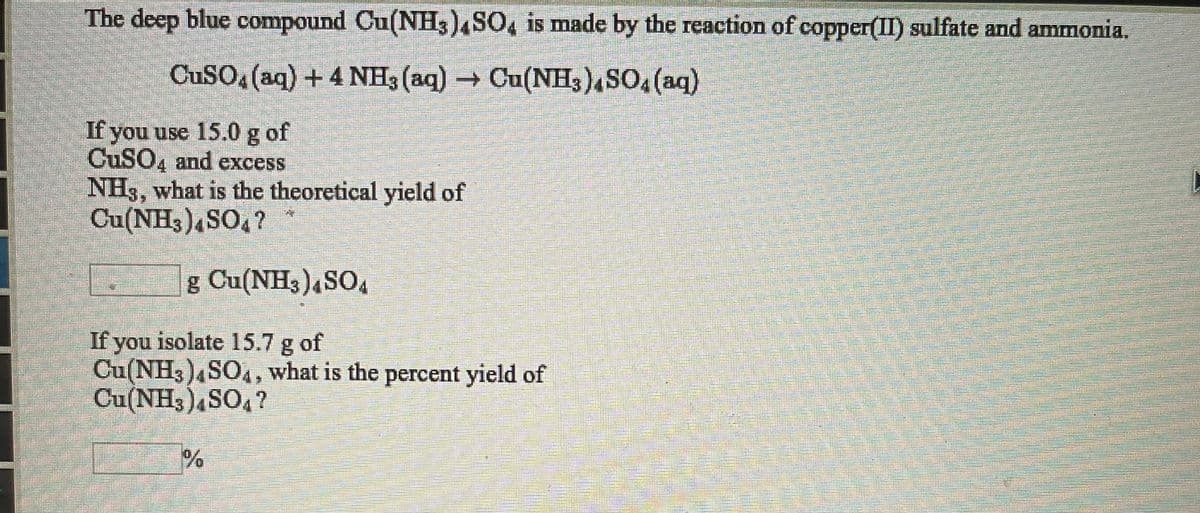The deep blue compound Cu(NH3)4SO4 is made by the reaction of copper(II) sulfate and ammonia. CuSO (aq) +4 NH3 (aq) Cu(NH3) SO (aq) If you use 15.0 g of CUSO4 and excess NH3, what is the theoretical yield of Cu(NH3)4 SO4 ? & Cu(NH3)4SO4 If you isolate 15.7 g of Cu(NH3)4SO4, what is the percent yield of Cu(NH3)4SO4?
The deep blue compound Cu(NH3)4SO4 is made by the reaction of copper(II) sulfate and ammonia. CuSO (aq) +4 NH3 (aq) Cu(NH3) SO (aq) If you use 15.0 g of CUSO4 and excess NH3, what is the theoretical yield of Cu(NH3)4 SO4 ? & Cu(NH3)4SO4 If you isolate 15.7 g of Cu(NH3)4SO4, what is the percent yield of Cu(NH3)4SO4?
Chemistry & Chemical Reactivity
9th Edition
ISBN:9781133949640
Author:John C. Kotz, Paul M. Treichel, John Townsend, David Treichel
Publisher:John C. Kotz, Paul M. Treichel, John Townsend, David Treichel
Chapter4: Stoichiometry: Quantitative Information About Chemical Reactions
Section: Chapter Questions
Problem 4PS: The balanced equation for the reduction of iron ore to the metal using CO is Fe2O3(s) + 3 CO(g) 2...
Related questions
Question

Transcribed Image Text:The deep blue compound Cu(NH3)4SO, is made by the reaction of copper(II) sulfate and ammonia.
CuSO (aq) +4 NH3 (aq) Cu(NH3)4SO, (aq)
If you use 15.0 g of
CUSO, and excess
NH3, what is the theoretical yield of
Cu(NH3)4SO, ?
g Cu(NH3)4SO,
If you isolate 15.7 g of
Cu(NH3),SO., what is the percent yield of
Cu(NH3)4SO4?

Transcribed Image Text:Cr203. What mass (in grams) of
Cr203 is produced if 0.147 g of chromium metal is converted completely to the oxide?
Mass =|
g Cr2 O3
What mass of O2 (in grams) is required for the reaction?
Mass -
g O2
Expert Solution
This question has been solved!
Explore an expertly crafted, step-by-step solution for a thorough understanding of key concepts.
This is a popular solution!
Trending now
This is a popular solution!
Step by step
Solved in 3 steps

Knowledge Booster
Learn more about
Need a deep-dive on the concept behind this application? Look no further. Learn more about this topic, chemistry and related others by exploring similar questions and additional content below.Recommended textbooks for you

Chemistry & Chemical Reactivity
Chemistry
ISBN:
9781133949640
Author:
John C. Kotz, Paul M. Treichel, John Townsend, David Treichel
Publisher:
Cengage Learning

Chemistry & Chemical Reactivity
Chemistry
ISBN:
9781337399074
Author:
John C. Kotz, Paul M. Treichel, John Townsend, David Treichel
Publisher:
Cengage Learning

Chemistry: The Molecular Science
Chemistry
ISBN:
9781285199047
Author:
John W. Moore, Conrad L. Stanitski
Publisher:
Cengage Learning

Chemistry & Chemical Reactivity
Chemistry
ISBN:
9781133949640
Author:
John C. Kotz, Paul M. Treichel, John Townsend, David Treichel
Publisher:
Cengage Learning

Chemistry & Chemical Reactivity
Chemistry
ISBN:
9781337399074
Author:
John C. Kotz, Paul M. Treichel, John Townsend, David Treichel
Publisher:
Cengage Learning

Chemistry: The Molecular Science
Chemistry
ISBN:
9781285199047
Author:
John W. Moore, Conrad L. Stanitski
Publisher:
Cengage Learning

Chemistry for Engineering Students
Chemistry
ISBN:
9781337398909
Author:
Lawrence S. Brown, Tom Holme
Publisher:
Cengage Learning

Chemistry: Principles and Practice
Chemistry
ISBN:
9780534420123
Author:
Daniel L. Reger, Scott R. Goode, David W. Ball, Edward Mercer
Publisher:
Cengage Learning

Chemistry: An Atoms First Approach
Chemistry
ISBN:
9781305079243
Author:
Steven S. Zumdahl, Susan A. Zumdahl
Publisher:
Cengage Learning